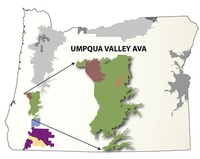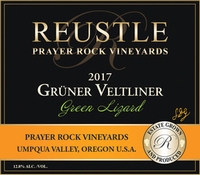Fast-forward a decade as I entered the wine business and became aware of the nascent Oregon wine industry, I began to hear about the development of vineyards in the Umpqua and watched the progress of the wines with great interest. Today, with 30 or so wineries and growing notoriety for fine wines, the Umpqua Valley is getting more recognition than ever.

The Umpqua Valley lies between the Coast Range and the Cascade Range. The Calapooya Mountains form the northern boundary of the Umpqua Valley drainage. On the other side of the divide, Oregon’s most famous growing region, the Willamette Valley, begins. The Rogue River Valley lies to the south of the Umpqua and has a warmer and drier climate. The Umpqua Valley AVA was established in 1984, well before most of today’s wineries. The appellation is about 65 miles long and 25 miles wide and encompasses the Elkton Oregon AVA and the Red Hills Douglas County Oregon AVA.
Because of its proximity to the Pacific, the climate differences across the Umpqua are substantial. Elkton is closer to the coast and is thus cooler and wetter than areas further inland. As you move inland and south of Roseburg, the climate becomes warmer and drier, closer to that of the Rogue Valley. The soils are diverse, with the marine sandstones and siltstones punctuated by volcanic intrusions. The topography across the Umpqua AVA is quite varied, with many tributary valleys and steep slopes as well as the flatter areas near the river.

Prior to becoming vintners, Stephen and Gloria Reustle owned a successful marketing company but had a desire to create world class wine. They moved from the east coast to California to search for the right spot, focusing on the Sonoma Coast. Following Richard Sommer’s path in a way, they ended up venturing north. There, they found an Umpqua Valley site with the right mix of climate, soil, water, aspect and topography and purchased a 200-acre property in 2001.
With the help of local experts, Stephen carefully selected grape varieties that had potential for the vineyard and mapped out the plantings. Winemaking began with the 2004 vintage and the current winemaking facility was completed in 2008. Now, there are over a dozen grape varieties planted on the hillside and production is around 8,000 cases a year.
Before becoming a vintner, Stephen discovered the elegance and raciness of the Grüner Veltliner grape on a motorcycle trip through Austria. He planted Grüner in his vineyard and, in 2005, was the first United States producer to market a varietal Grüner Veltliner. Reustle has perhaps received the most notoriety for Grüner Veltliner and Syrah.
I first sampled Reustle Prayer Rock Vineyard Grüner Veltliner at a wine competition several years ago and was impressed with its enchanting display of the grape’s characteristics. The fruit flavors of lime and lemon were underlain by a green and herbaceous flavor that can be described as green bean, lentil or white pepper. The wine had a rich texture that only the best Austrian Grüners display and the brilliant acidity made it a well-balanced delight. At that time, I had never tasted a United States Grüner so true to the classic style. Subsequent vintages have proven consistently delicious and the 2017 “Green Lizard” (a reference to the Smaragd designation of Austria’s Wachau) Grüner Veltliner is definitely worth a special effort to try.

I recently tried the 2017 Reustle Prayer Rock Vineyard Estate Syrah. In keeping with previous vintages, the 2017 combines the power of the grape with a rare delicacy and balance. This bottle combines luscious blackberry and black raspberry fruits with notes of dark chocolate, rose petal, vanilla, earth and spice. The 2018 is newly released and shares these delectable characteristics.
The Reustle range of wines extends well beyond their most famous varieties. You can also find excellent renditions of Riesling, Pinot Gris, Pinot Noir, Grenache, Malbec, Tempranillo and more. They also make a dessert wine of Tempranillo called Rojo Dulce which bears a marked resemblance to a fine Port.
This can be just the beginning of your Umpqua Valley exploration. The Rieslings, Gewurztraminers and Pinot Noirs of Brandborg in Elkton are well worth seeking out. Earl and Hilda Jones of Abacela Vineyards in the southern Umpqua AVA specialize in Spanish varieties like Albariño and Tempranillo. The wines of Girardet, Cooper Ridge, Spangler and the revitalized HillCrest are all worth sampling. Plan a visit and you will fall in love with the Umpqua Valley.
